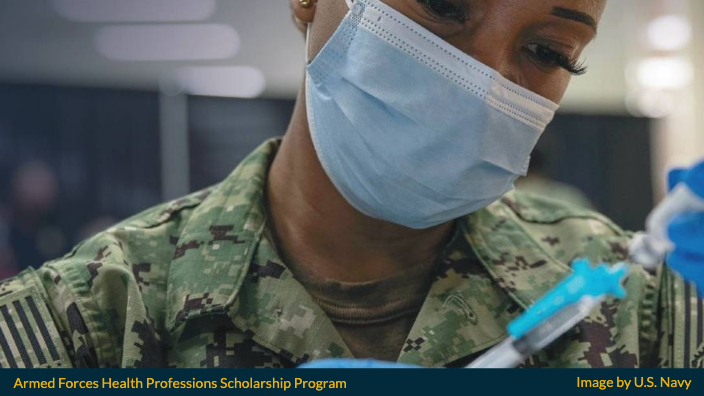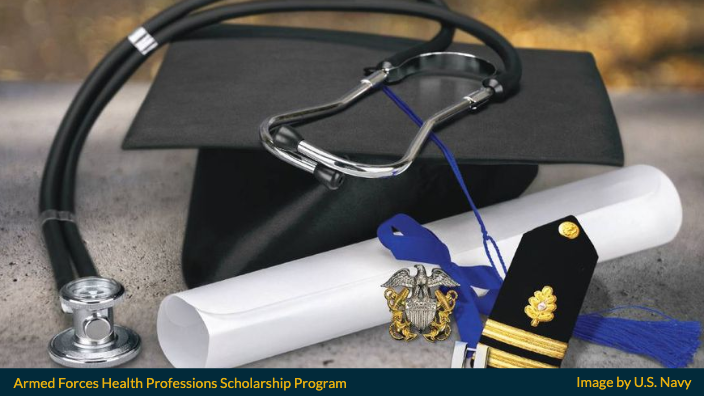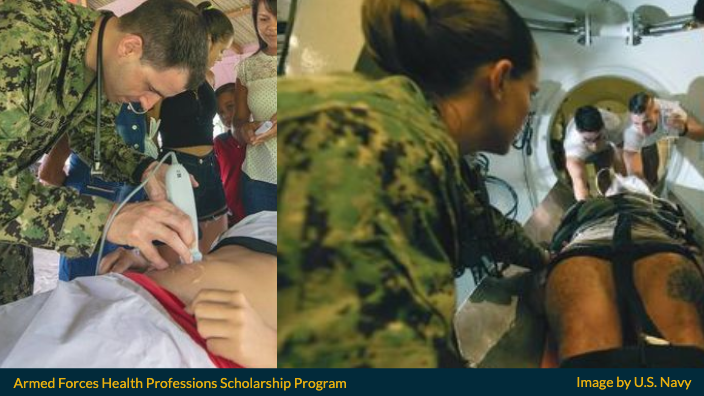This guide provides helpful information for those who are looking to become a healthcare provider in the Navy through the Health Professions Scholarship Program during Fiscal Year 2025.
This program involves many detailed requirements and is generally very competitive.
So, let us jump right into the details.
What is the HPSP?
The Armed Forces Health Professions Scholarship Program (HPSP) is a Department of Defense program that provides financial support and incentives to help students navigate the unique and challenging opportunities of medical, dental, and allied health sciences schools.

HPSP covers tuition, fees, and education-related costs for up to four years if you’re in medical, dental, psychology, PA, or optometry school. You also get a monthly stipend—over $2,300—and a $20,000 signing bonus for committing to three or four years as a Navy physician.
Total program value: over $300,000 for a four-year degree.
After graduation, you commission as a Naval officer. That means top-tier training, some of the highest board pass rates in the country, and full officer pay—far beyond what civilian residencies offer. Plus, veteran benefits like the Post-9/11 GI Bill and military healthcare.
The catch: you owe at least two years of active duty or one year per scholarship year—whichever is longer.
HPSP vs. HSCP
Both fund medical students. Both come with a service commitment. But they work differently.
HSCP is Navy-only—HPSP is DoD-funded, so you can commission into other branches. HPSP students stay civilians, get full tuition covered, and receive a stipend. HSCP students don’t get full tuition covered but earn active-duty pay and military benefits while in school.
Big picture—both programs offer similar total value. The difference is how you get it.
Summary of Benefits
Below is a list summarizing the benefits of HPSP:
- Covers 100% of tuition and school fees (up to four years)
- Book, Supply, and Equipment Reimbursement
- Annual Training for HPSP (45 days)
- A monthly stipend of $2,391.60
- A $20,000 HPSP Signing Bonus is available to medical and dental students
- Comprehensive medical and dental insurance
- Continuing medical and dental Education
Why Choose the Navy?

Assess every branch’s benefits. Look into the Uniformed Services University of Health Sciences (USU). The right choice isn’t just about money—it’s about fit.
The Navy provides options in aviation and submarine medicine, plus standard medical officer roles on ships or with land-based forces.
Firsthand experience matters—talk to people. Each branch has its own culture. Finding one that matches your personality is critical for long-term satisfaction.
Serving as a doctor with the Marines goes through Navy Medicine. The Navy handles all medical care for the Marine Corps.
Navy Medicine also offers humanitarian missions—deployments to South America, Southeast Asia, and beyond.
Another major factor: most duty stations are in coastal cities.
Navy Medicine Duty Stations
Becoming a Naval Officer means getting stationed in prime locations—both stateside and overseas.
Family Practice Internships and Residencies:
- Washington, D.C.—Walter Reed National Military Medical Center.
- Camp Pendleton, CA—Naval Hospital Camp Pendleton.
- Camp Lejeune, NC—Naval Hospital Camp Lejeune.
- Jacksonville, FL—Naval Hospital Jacksonville.
Other Internship and Residency Programs:
- San Diego, CA—Naval Medical Center San Diego.
- Portsmouth, VA—Naval Medical Center Portsmouth.
- Washington, D.C.—Walter Reed National Military Medical Center.
Stateside Duty Stations in Navy Medicine:
- Bremerton, WA—Naval Hospital Bremerton.
- Pensacola, FL—Naval Hospital Pensacola.
- Quantico, VA—Naval Health Clinic Quantico.
- Annapolis, MD—Naval Health Clinic Annapolis.
- Charleston, SC—Naval Health Clinic Charleston.
- Corpus Christi, TX—Naval Health Clinic Corpus Christi.
- Newport, RI—Naval Health Clinic New England.
- Patuxent River, MD—Naval Health Clinic Patuxent River.
Overseas Duty Stations:
- Europe: Naples, Italy—Naval Hospital Naples. Rota, Spain—Naval Hospital Rota. Sigonella, Italy—Naval Hospital Sigonella.
- Asia: Yokosuka, Japan—Naval Hospital Yokosuka. Okinawa, Japan—Naval Hospital Okinawa.
- Other Locations: Guam—Naval Hospital Guam. Guantanamo Bay, Cuba—Naval Hospital Guantanamo Bay.
Applying for the Navy HPSP

The ideal time to apply for a four-year scholarship is the fall before your professional school year.
Students in medical, dental, or optometry school should apply for scholarships as soon as possible because applications are accepted all year round and scholarships are granted regularly.
The application process takes 12-16 weeks.
You can apply before getting accepted to medical or dental school, but you must get accepted before getting a scholarship.
Basic Qualifications
Citizenship
Applicants must be U.S. citizens.
Age
Applicants must be commissioned by the time they reach the age of 42. The board will handle waivers on a case-by-case basis.
Age Waiver
Exceptional candidates over the age limit can get a waiver—but only in rare cases. The Navy looks for standout records or highly sought-after skills.
Approval isn’t guaranteed. Priority goes to understaffed specialties and fields with ongoing recruiting challenges.
Age waivers are considered for applicants between 42 and 47.
Physical
Applicants must meet Navy physical and medical standards under the Manual of the Medical Department, Chapter 15.
Education
Applicants need to be enrolled or accepted at an approved school in the U.S. or Puerto Rico, studying a health-related field.
Undergrads must keep a 3.0 GPA on a 4.0 scale. Anything lower doesn’t meet the standard.
Full-time enrollment is required. Drop below, and you’re out.
A curriculum plan outlining prerequisites and expected graduation must be submitted with the application. Updates happen as BUMED requires.
Falling short on academic or military standards: The Chief of Navy Personnel has the authority to remove you from the program.
After each academic term, BUMED may request official transcripts. Be ready to submit them.
Failing to disclose all transcripts or tampering with records results in immediate dismissal. No second chances.
Medical Corps (MC)

The Navy Medical Corps (MC) relies heavily on this program as the major source of admittance for Navy physicians.
The Commander, Navy Recruiting Command (CNRC), the MC Officer Community Manager (OCM), BUMED, and the Officer of the Chief, Medical Corps, collaborate to optimize potential medical department physician gains via this initiative.
Undergraduate coursework must have a GPA of 3.2 on a 4.0 scale.
Applicants must have a minimum MCAT score of 500, with 124 in each of the four subsections.
Waivers will be handled case by case.
During the program, the officer must remain a full-time student.
Prior to graduating and going to active-duty, applicants must take and pass the United States Medical Licensing Examination (USMLE) parts I, IICK, and IICS or the Comprehensive Osteopathic Medical Licensing Examination (COMLEX) levels I, II CE, and II PE.
Students must pass the USMLE or COMLEX Part I before the start of the third year of medical/ osteopathic school’s academic curriculum.
Failure to pass these examinations after two attempts or to obtain a valid state license following internship completion will cause redesignation and completion of incurred active-duty service obligations in another community or separation from the United States Navy and recoupment of Navy expenditures under the terms and provisions of the service agreement and applicable Navy regulations.
Dental Corps (DC)
The Navy Dental Corps (DC) relies heavily on this initiative to recruit Navy dentists.
The CNRC, DC OCM, BUMED, and the Officer of the Chief, Dental Corps, collaborate to optimize potential dental officer gains via this program.
Prior to graduating and reporting to active duty, applicants must take and pass Parts I and II of the National Board Dental Exam (NBDE).
NBDE part I must be taken and passed during the third year of the dentistry school’s academic program.
Applicants must complete part II of the NBDE throughout their fourth-year academic curriculum in December.
After two attempts, failure to pass these tests may cause separation from the program. Failure to obtain a valid state license within one year of reporting to active duty will cause redesignation and fulfillment of incurred active-duty service obligations in another community, or separation from the United States Navy and recoupment of Navy expenditures under the terms and provisions of the service agreement and applicable Navy regulations.
Applicants from jurisdictions that need a five-year residency prior to licensing will be granted an additional six months.
Medical Service Corps (MSC)
The Navy Medical Service Corps (MSC) uses this specialty-specific program as one of the major sources of officer accessions.
The MSC OCM, in collaboration with BUMED and the Office of the Chief, Medical Service Corps, evaluates and determines which MSC specialties are qualified for this program, as specified in a memorandum to CNRC.
This program provides a pipeline for the physician assistant, optometry, podiatry, and clinical psychology specialties.
At the moment, online degree programs are not permitted.
Physician Assistant
Must be enrolled or at least approved for admission to an accredited master’s program in Physician Assistant studies. No exceptions.
The program must have Accreditation Review Commission on Education for the Physician Assistant (ARC-PA) certification. That’s non-negotiable.
Degree completion: 12 to 24 months, standard. If the program runs 30 months, benefits may extend accordingly. But no more than that.
A professional review board locks in the contract length before the applicant even starts the program. That decision is final.
Before enrollment, applicants need an official degree or course completion plan. That plan sets the expected graduation or program completion date—no surprises.
Before active duty, passing the Physician Assistant National Certification Exam (PANCE) is mandatory. No passing, no progression.
Fail twice? That’s it. Separation from the U.S. Navy. Plus, every dollar spent under the service agreement gets recouped. Navy rules apply, no exceptions.
Optometry
Must be enrolled in an optometry school accredited by the American Optometric Association’s Council on Optometric Education. No accreditation, no eligibility.
Before active duty, passing all three parts of the National Board of Examiners in Optometry is required. No exceptions.
New Navy optometrists get one year after starting active service to secure their license. Miss that deadline: That’s a problem.
Podiatry
Applicants must be in a program approved by the American Podiatric Association’s Council on Education.
Part I of the exam must be passed before the third-year academic curriculum starts, with results sent to the AFHPSP program manager’s office by September 15 of that year.
Part II must be taken and passed by October 15 of the fourth year.
Failing either exam twice can lead to separation from the program. Not securing a valid state license within a year of starting active duty results in redesignation to another field or separation from the Navy. In that case, the Navy will recover its costs under the service agreement and applicable regulations.
Clinical Psychology
Applicants must be in an APA-accredited Ph.D. or PsyD program in clinical or counseling psychology and have completed at least one year.
To qualify for a scholarship, they must submit a letter from their training director confirming good standing and provide graduate transcripts for review by the clinical psychology specialty leader. Missing transcripts or failure to progress in training can lead to disqualification.
After earning their Ph.D., applicants must complete the Navy’s internship program.
The licensing process must be finished within 18 months of completing the 12-month internship.
Failing to secure a valid state license within that time leads to redesignation to another field or separation from the Navy. If separated, the Navy will recover its costs under the service agreement and applicable regulations.
Nurse Corps (NC)
This program is used by the Navy Nurse Corps (NC) for graduate level nursing studies.
Students with a non-nursing bachelor’s degree who intend to pursue a nursing degree are eligible for direct admission Master of Science in nursing (MSN) degrees.
The program must be finished within 24 months after its commencement. At the moment, online degree programs leading to a direct entry MSN are not permitted.
Applicants must be enrolled full time in or admitted to a college or university and its nursing school that offers a graduate degree in nursing approved by the Accreditation Commission for Education in Nursing or the Commission on Collegiate Nursing Education.
Upon graduation, direct entry MSN students must obtain and maintain a valid, unrestricted license to practice as a professional registered nurse from a state, territory, or the District of Columbia that is based on the National Council Licensing Examination – Registered Nurse (NCLEX-RN), administered by the National Council of State Boards of Nursing.
The NCLEX-RN examination must be taken as soon as possible after graduation and prior to reporting for active duty.
Navy HPSP Service Obligation

Appointees owe one year of service for each year in the program.
For shorter periods, every additional six months adds six months. Any period of 15 days or more counts as six months.
Anyone with less than a three-year service obligation must still serve a minimum of three years on active duty.
This commitment is separate from any other active-duty obligation.
All Naval Officers commit to eight years of service. Any time not spent on active duty will be in the Selected Reserves or Inactive Ready Reserves.
Members must sign an agreement stating they will:
- Accept an appointment in the appropriate officer corps, USN, on the active-duty list after completing the HPSP.
- Fulfill any active-duty requirement tied to HPSP participation.
- If they withdraw or fail to meet standards, they must accept a commission as an Unrestricted Line Officer, USN, if offered. If unqualified for reappointment, they must repay any expenses from their HPSP participation unless the Secretary of the Navy grants a waiver in the government’s best interest. Those not eligible for reappointment will face administrative separation.
- Understand and meet licensure and certification requirements at their own expense.
- Be ready for immediate active duty after completing coursework.
Annual Training
HPSP members must complete 45 days of active duty each year while in student status.
Unless legislation changes, pay and allowances for this period will be at the O-1 grade.
Prior military service counts toward pay longevity.
Uniforms are required on active duty at any military installation.
More Information About the Benefits
BUMED handles contracts with educational institutions to cover tuition and approved expenses for all program participants.
Members get reimbursed for required textbooks, equipment, and supplies. Claims must include dated, itemized receipts and certification from the school. Reimbursement is limited to what non-members would pay at the same institution. State and local taxes are not refundable.
While on inactive duty, members receive a monthly stipend set annually by the Assistant Secretary of Defense (Health Affairs).
The stipend starts on the latest of these three dates, known as the Benefit Start Date (BSD):
- The day the member takes the oath of office
- The day the program agreement/contract is signed
- The academic year’s start date
If eligibility begins mid-session, the full academic session is charged. The BSD determines when stipend payments begin.
The stipend continues until the course of study is completed unless the member is suspended or withdrawn. Payments stop if the academic program ends more than 45 days before graduation.
Members can accept financial aid from civilian institutions as long as it doesn’t create a service obligation after graduation.
Unless legislation changes, officers receive O-1 pay and allowances during active-duty training. Prior military service counts toward pay longevity.
Additional Medical School Information
Your medical school experience will be the same as your peers, except you’ll apply for the military match in your fourth year.
You’ll almost certainly be placed in a military training program. Each year, a limited number may defer military service for a civilian residency.
In your first year of training, you can apply for either straight-through residency (comparable to civilian residency) or a General Medical Officer (GMO) post.
Those in straight-through residency begin their service obligation immediately after completing training.
GMOs have their time in that role count toward their training obligation. About 75% later apply for military residency, while around 25% complete their HPSP service and separate from the Navy.
Those who finish a Navy residency serve as staff physicians to fulfill their obligation, then decide whether to continue their military career.
Non-Selection
Regrettably, only a small percentage of graduating medical students (civilian and military) are picked.
Fortunately, the Navy allows for reapplications in any discipline, and those who thrive as a GMO or staff physician frequently succeed in reapplication.
No Opening for Specialty of Choice
Medical officers who discover an interest in a specialty that is misaligned with the Navy’s mission often complete their commitment and are extremely competitive candidates for the civilian match.
There are very few fourth-year medical students who can match your experience.
General Medical Officer
General Medical Officers (GMOs) are licensed physicians who have completed medical school and an internship.
Often called general practitioners, they serve in the Flight, Marine Corps, Undersea/Dive, or Surface Warfare communities. Their role covers emergency care, health maintenance, and first-line trauma management.
They also handle clinic operations—supply management, pharmacy setup, and staff training. Highly skilled Corpsmen assist in running the medical department.
Flight Surgeons go through six months of flight school and aviation physiology training to care for pilots and aviation personnel. They can be assigned to fixed-wing or helicopter units, sea-air rescue teams, or even the Blue Angels.
Undersea Medical Officers (UMOs) get specialized training, including radiation health and hyperbaric medicine in Panama City Beach, Florida, before qualifying as Navy Divers.
UMOs are assigned to Navy SEALS, Explosive Ordnance Disposal (EOD), and submarine squadrons.
Additionally, a few billets for diving research and instruction are available.
UMOs do not deploy with submarines; rather, they supervise the medical care given by highly trained Independent-Duty Corpsmen (IDC) who do.
Other General Medical Officers are assigned to the Marine Corps, the Surface Navy, or to a ship or shore command.
You are frequently the senior medical authority wherever your ship or Marine unit deploys, and you are a critically important element of the combat team.
Annual Training
HPSP participants get 45 days of Annual Training (AT) for each year in the program.
Only one AT can be taken per fiscal year (October 1–September 30).
During AT, stipend payments stop, and participants receive active-duty pay and benefits based on their rank.
BUMED Accessions staff process all student orders using information from the Annual Training Order Request Form.
Annual Training Types
Officer Development School (ODS)
ODS isn’t required for those with prior Navy commissioned service, Naval Academy graduates, or former NROTC participants.
For everyone else—including those with prior Navy enlisted service or commissions from other branches—ODS is mandatory.
Your first AT should ideally be at this five-week program in Newport, Rhode Island.
ODS covers military basics: skills, uniform regulations, and etiquette.
It’s usually completed before professional school but can be taken later. It must be done before active duty.
If you wait until after graduation, your detailer will add ODS to your active-duty orders.
Clinical Clerkship
Clinical clerkships are short-term rotations at Navy hospitals or clinics, where trainees work under the supervision of credentialed Navy physicians.
These typically last 2–4 weeks and provide hands-on experience, exposure to the Navy medical system, and opportunities to meet program directors and department heads. Many use this time to interview for future internships.
The remaining days of the 45-day AT requirement are covered by School Orders, allowing students to return to school while still receiving active-duty pay and benefits.
Most clerkships take place between the end of the junior year and the start of the final year.
School Orders
In the early years of medical school, taking a month off for AT may not be practical. Instead, HPSP participants can request School Orders. This allows them to stay enrolled and follow their normal schedule while receiving full active-duty pay and benefits.
While on School Orders:
- No uniform is required
- No check-in at a military facility is needed
- Travel is limited—no overseas trips or vacations, but weekend getaways within 300 miles are allowed
Research and Operational Medicine Clerkship
For those who don’t attend ODS—Naval Academy graduates, former naval officers, and NROTC participants—research and operational medicine clerkships offer another AT option.
These rotations last up to four weeks and involve travel for specialized training. The remaining 17 days of AT are covered by School Orders, allowing students to continue their education while receiving active-duty pay and benefits.
HPSP Frequently Asked Questions
How does the payback work?
You must apply for military residency training through the graduate medical education selection board process, often known as military match.
There are occasional openings for civilian residencies in understaffed specialties.
Your obligation following residency training will be defined by your HPSP contract.
How do I pursue my specialty of choice?
Navy Graduate Medical Education (GME) is a meritocracy that evaluates applicants on their achievement in medical school, internship, and residency, as well as their board scores, research, operational experience, and other intangible indicators of leadership ability.
The Graduate Medical Education Selection Board (GMESB) meets annually to rate all applications.
The highest-ranked applicants are assigned to their desired specialty and location. Each December, the findings of this list are made public (known as the Military Match).
What is the Military Match?
Both civilian and military residencies are highly competitive. Students from all medical schools compete for a limited number of spots, and even top candidates have no guarantees.
The military match happens in December, while the civilian match takes place in the spring.
HPSP students can apply for the Navy Active-Duty Delay for Specialists (NADDS) program, which allows them to complete a civilian residency.
Like all residency programs, slots are limited, and only the most competitive applicants are selected.
Can I sub-specialize?
This is determined by your specialty and the timing. It is impossible to foresee the Navy’s demands, and the Navy’s needs affect what and how many people we teach.
In general, the closer your specialization is to the Navy’s mission and needs, the more likely there will be a chance to sub-specialize.
Can I be called into active duty while in school?
No. While in medical school, your goal is to become the greatest doctor possible, and the HPSP office works diligently to ensure that your service duties do not obstruct your study.
Your principal responsibilities are to maintain an annual health certification and to take part in one six-week Active-Duty Training (ADT) session per year.
What is Active-Duty Training (ADT)?
HPSP students serve as Navy reservists and must complete six weeks of active duty each year.
Since medical school is the priority, the HPSP central office helps students plan their Active Duty for Training (ADT) to fit their education and career goals.
The typical ADT schedule looks like this:
- First ADT: Most students attend Officer Development School (ODS).
- Second ADT: Many choose School Orders to stay local and study for board exams while receiving active-duty pay and allowances.
- Third & Fourth ADT: Used in the early months of the fourth year for rotations at military hospitals, interviews, and audition rotations.
A major perk—along with active-duty pay—is that travel, lodging, and food costs are covered during ADT.
What is Officer Development School?
Navy Bootcamp is designated for the enlisted indoctrination process. Medical Officers undergo a totally distinct indoctrination procedure.
Officer Development School (ODS) is in Newport, Rhode Island. Five weeks of training is substantially less demanding than bootcamp.
ODS should serve as a springboard for your officer growth and to familiarize you with the norms, courtesies, and traditions of naval service.
What are the specialty training opportunities in Navy Medicine?
Each year, the Navy determines how many specialists it needs to meet mission demands.
Some fields, like dermatology, are just as competitive in the Navy as they are in the civilian sector. No recruiter can guarantee placement in a specialty.
Opportunities and competition in Navy medicine mirror the civilian world—being a top candidate is the only way to secure a spot.
Through NADDS, HPSP students can request approval to complete a civilian residency before starting active duty.
Specialty training isn’t guaranteed from the start—during the intern year, applicants compete for residency spots.
What else does Navy Medicine offer aside from traditional medical practice and training?
Navy Medicine extends far beyond hospital walls. Medical officers serve in Congress, the White House Medical Unit, and the CDC. The Navy has also been a strong pipeline for the Astronaut Program.
With a Global Health Engagement (GHE) credential, officers may serve as health advisers to international organizations like NATO or as Health Attachés at U.S. Embassies in places like Hungary, Vietnam, and New Zealand.
Elite military units also have openings for Navy medical officers.
Beyond combat and maritime defense, the Navy plays a major role in global partnerships. The USNS Comfort and USNS Mercy deploy to Southeast Asia and South America, providing disaster relief and medical care to underserved communities.
While most roles focus on patient care, research opportunities exist at the Navy Medical Research Center in Silver Spring, Maryland, and in units worldwide, including Africa, South America, and Southeast Asia. Research can also be part of daily clinical work.
How do I become competitive in the HPSP selection board?
Selection committees are particularly interested in an applicant’s academic, medical, and professional capabilities, as well as evidence of a commitment to service.
They are held twice a month and around 85% of candidates receive a scholarship.
Successful HPSP applicants typically have a GPA of 3.65 and an MCAT score of 507.
When should I apply for the HPSP?
You do not need to be accepted to medical school to apply, but you must be admitted to an accredited United States Medical School to earn the scholarship.
Scholarships are offered on a first-come, first-served basis, with most applicants for four-year scholarships coming in early spring (process started much beforehand).
Scholarships for three years are often offered during the first year of medical school and typically expire in the spring.
How do I apply for the HPSP?
To begin the process, contact a Medical Officer Recruiter.
The application process starts with the review of your current resume or curriculum vitae, so please have this ready.
Please keep in mind that there are several types of recruiters, and while many are well knowledgeable about Navy procedures, many are unaware of the intricacies of physician training.
Email MedicalVIP.fct@navy.mil to get linked to a Medical Officer Recruiter in your area.
The recruiter will walk you through the application process, which might take many months to complete.

